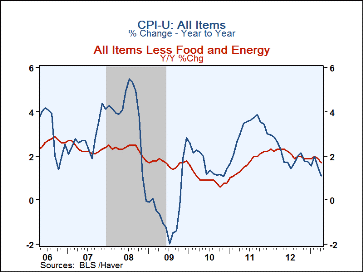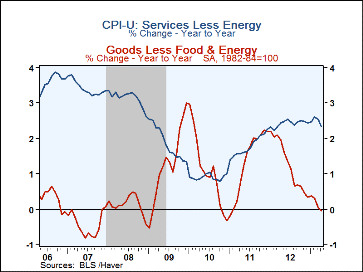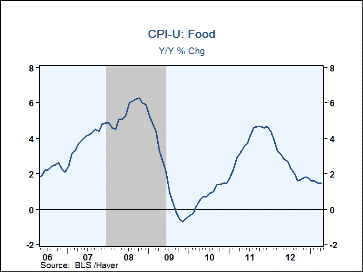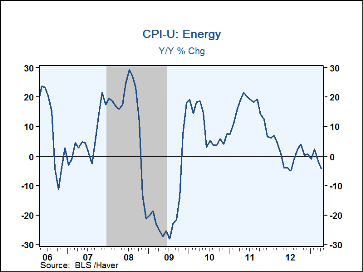 Global| May 16 2013
Global| May 16 2013U.S. CPI Continues Downward With Energy Prices; Core Prices Up Minimally
by:Tom Moeller
|in:Economy in Brief
Summary
Price inflation remains under control. The consumer price index fell 0.4% (+1.1% y/y) during April, doubling its unrevised March shortfall. Expectations were for a lesser 0.2% decline in the index. Prices excluding food and energy [...]
Price inflation remains under control. The consumer price index fell 0.4% (+1.1% y/y) during April, doubling its unrevised March shortfall. Expectations were for a lesser 0.2% decline in the index. Prices excluding food and energy ticked up 0.1% (1.7% y/y), again weaker than the expected 0.2% rise.
A 4.3% drop (-4.3% y/y) in energy prices led the overall CPI lower as it did in March with a 2.6% decline. Gasoline prices plunged 8.1% (-8.3% y/y). Fuel oil prices also declined by a sizable 4.4% (-5.6% y/y). To the upside, prices for natural gas increased 4.4% (7.6% y/y) while electricity costs rose 0.5% (1.1% y/y). Food prices edged up 0.2% (1.5% y/y). Cereals & bakery product prices increased 0.6% (1.3% y/y) while prices of meats, poultry, fish and eggs rose 0.4% (1.5% y/y). Dairy product costs were unchanged (0.6% y/y) and fruit & vegetable prices fell 1.4% (+2.1% y/y).
Prices for goods less food and energy were unchanged (-0.1% y/y). Furniture & bedding costs also were unchanged (-0.5% y/y) accompanied by a 0.6% drop (-1.6% y/y) in home appliance prices. Apparel prices were off 0.3% (+0.3% y/y) but new car & truck costs rose 0.3% (1.2% y/y). Medical care goods prices again ticked up 0.1% (0.7% y/y) while recreational goods prices slipped 0.1% (-1.5% y/y).
The gain in core services prices backed off to 0.1% (2.3% y/y), its weakest rise since August. A 0.4% decline (+2.6% y/y) in public transportation prices led the way lower while medical care services prices slipped 0.1% (+3.4% y/y). Higher tuition costs & fees offset some of these declines with a third straight 0.3% increase (3.9% y/y) while shelter costs (32% of the CPI) rose a steady 0.2% (2.2% y/y). Owners equivalent rent of primary residences also increased 0.2% (2.1% y/y). Recreational services prices again slipped 0.1% (+2.0% y/y).
The consumer price data is available in Haver's USECON database while detailed figures can be found in CPIDATA. The expectations figure is from Action Economics and is found in the AS1REPNA database.
| Consumer Price Index (%) | Apr | Mar | Feb | Apr Y/Y | 2012 | 2011 | 2010 |
|---|---|---|---|---|---|---|---|
| Total | -0.4 | -0.2 | 0.7 | 1.1 | 2.1 | 3.1 | 1.6 |
| Total less Food & Energy | 0.1 | 0.1 | 0.2 | 1.7 | 2.1 | 1.7 | 1.0 |
| Goods less Food & Energy | 0.0 | -0.1 | -0.0 | -0.1 | 1.3 | 1.3 | 1.1 |
| Services less Energy | 0.1 | 0.2 | 0.2 | 2.3 | 2.4 | 1.8 | 0.9 |
| Food | 0.2 | 0.0 | 0.1 | 1.5 | 2.6 | 3.7 | 0.8 |
| Energy | -4.3 | -2.6 | 5.4 | -4.3 | 1.0 | 15.2 | 9.6 |
Tom Moeller
AuthorMore in Author Profile »Prior to joining Haver Analytics in 2000, Mr. Moeller worked as the Economist at Chancellor Capital Management from 1985 to 1999. There, he developed comprehensive economic forecasts and interpreted economic data for equity and fixed income portfolio managers. Also at Chancellor, Mr. Moeller worked as an equity analyst and was responsible for researching and rating companies in the economically sensitive automobile and housing industries for investment in Chancellor’s equity portfolio. Prior to joining Chancellor, Mr. Moeller was an Economist at Citibank from 1979 to 1984. He also analyzed pricing behavior in the metals industry for the Council on Wage and Price Stability in Washington, D.C. In 1999, Mr. Moeller received the award for most accurate forecast from the Forecasters' Club of New York. From 1990 to 1992 he was President of the New York Association for Business Economists. Mr. Moeller earned an M.B.A. in Finance from Fordham University, where he graduated in 1987. He holds a Bachelor of Arts in Economics from George Washington University.










